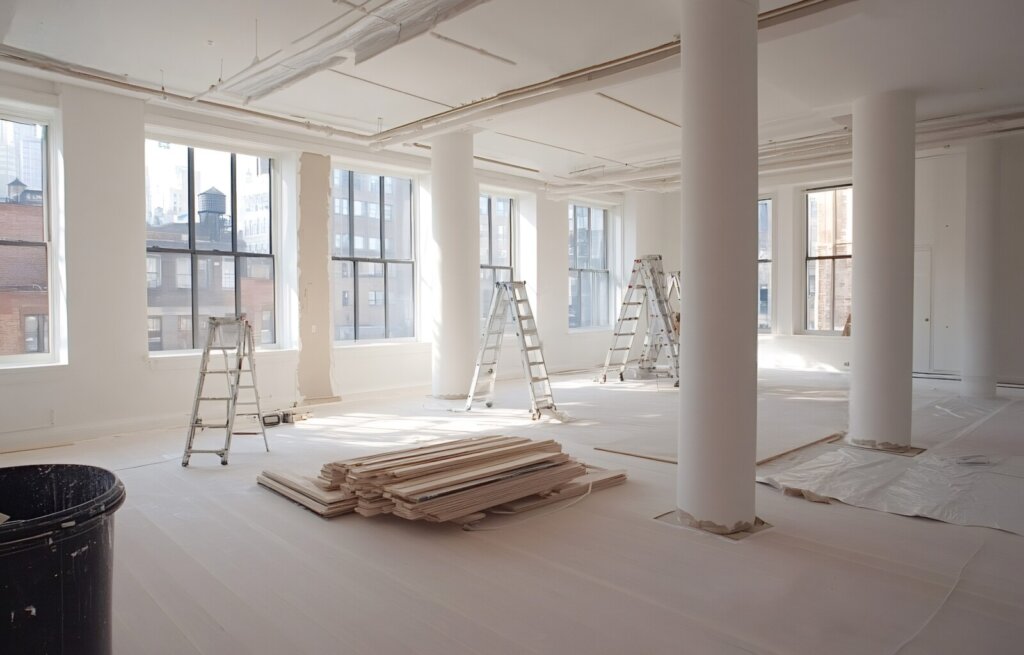Refurbishment vs Renovation: Understanding the Key Differences

When planning a commercial property upgrade, two terms often come up – refurbishment and renovation. While they’re sometimes used interchangeably, they have distinct meanings, scopes, and implications.
This blog explores the difference between refurbishment and renovation, helping you make informed decisions for your commercial space.
What Do We Mean by Refurbishment?
Refurbishment typically refers to making improvements to an existing space without major structural changes. It’s often cosmetic or functional in nature.
Common Refurbishment Activities:
- Repainting or redecorating.
- Replacing flooring or ceiling tiles.
- Upgrading lighting or HVAC systems.
- Furniture replacement or rearrangement.
- General maintenance and repairs.
Refurbishment is ideal when you want to refresh a workspace, improve energy efficiency, or modernise a facility without altering its core structure.
Looking to update your existing office or retail space? Our Commercial Refurbishment services provide tailored solutions for all kinds of commercial properties.
What Does Renovation Involve?
Renovation is more extensive and may involve structural or architectural changes. It’s about restoring or improving a space that might be outdated or deteriorated.
Common Renovation Activities:
- Removing or adding walls.
- Changing layouts or floorplans.
- Plumbing and electrical reconfiguration.
- Strengthening or repairing foundations or roofs.
- Full-scale interior remodelling.
Renovation is usually necessary when a building is older, out of compliance with codes, or needs to meet new business functions.
For comprehensive transformations involving both design and execution, explore our Design and Build services.
Refurbishment vs. Renovation – Key Differences
| Aspect | Refurbishment | Renovation |
| Scope | Cosmetic and surface-level upgrades | Structural and functional changes |
| Timeframe | Short to medium | Medium to long |
| Cost | Lower | Higher |
| Common Use Case | Updating modern offices | Reviving older buildings |
| Required Permissions | Rarely needed | Often needed |
How to Decide – Refurbishment or Renovation?
1. Assess the Building Condition
If the building is structurally sound but outdated, refurbishment may be enough. If it has structural issues or outdated infrastructure, renovation might be required.
2. Define Your Objectives
- Want a fresh look?
- Need a new layout or added functionality?
3. Budget Considerations
Renovations generally require more time and capital investment. Consider lifecycle costs, not just upfront spend.
4. Compliance & Safety
Renovations may be necessary to bring a space up to code or ensure compliance with modern safety standards.
Common Commercial Settings Where Each Applies
1. Offices: Office refurbishment is common for rebranding or minor layout tweaks. Renovation is more suitable for complete reconfigurations.
2. Retail Stores: Refurbishment helps keep stores visually fresh. Renovation might be required for major rebranding or footprint changes.
3. Healthcare & Clinics: Refurbishment in healthcare units can upgrade patient experience. Renovation may involve improving medical-grade infrastructure.
4. Hospitality: Refurbishing rooms or lobbies is typical, while renovation may involve layout changes or facility additions.

Final Thoughts
The distinction between refurbishment and renovation lies in their scope and purpose. Refurbishment is often the faster and more cost-effective route when the goal is to freshen up space. Renovation, while more involved, allows for structural change and long-term value.
Knowing the difference helps ensure your investment aligns with your business goals, timelines, and budget.
FAQs
Can a commercial property undergo both refurbishment and renovation?
Yes. Many projects involve both refurbishing some areas while renovating others.
How do building regulations differ between refurbishment and renovation?
Renovation often requires planning permission and adherence to updated building codes, while refurbishment usually doesn’t.
Which option is more disruptive to day-to-day operations?
Renovation tends to be more disruptive due to structural work, while refurbishment can often be completed in phases or off-hours.
What’s the ROI on refurbishment vs renovation?
Refurbishment generally offers quicker ROI with lower upfront costs. Renovation delivers value over a longer term.
Do I need an architect for refurbishment?
Not always. Architects are usually required for renovation due to structural design needs, while refurbishment can be handled by fit-out specialists.
Can refurbishment qualify for sustainability or energy efficiency incentives?
Yes, especially if it includes upgrades like LED lighting, insulation, or HVAC systems.
Is there a tax benefit difference between refurbishment and renovation?
In the UK, tax relief may vary. Consulting a tax advisor is recommended to assess capital allowances.